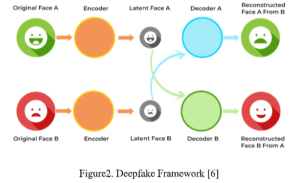Asia Mahdi Naser Alzubaidi
Asst. Prof. Dr. Heba Jabbar Aleqabie
Faculty of Computer Science and Information Technology
Deepfake technology has been rapidly advancing over the past few years, allowing for the creation of realistic but false images or videos of an event that never happened. This technology utilizes artificial intelligence algorithms to superimpose the image of one person onto the body of others (Figure 1). The process entails feeding the video of two people into deep learning and training algorithms to exchange faces

Deepfake employs a facial mapping method and artificial intelligence to replace a person’s face with the face of another individual in a video. People are more likely to accept readily believed things by effectively generating a “false” illusion that someone either stated something they didn’t say or is someone they aren’t.
From a technological standpoint, deepfakes are created using machine learning methods such as convolutional neural networks, which are artificial intelligence computer systems built to spot trends in information. To create a deepfake video, the developer first feeds numerous hours of actual video footage into a deep neural network. This network is then “trained” to recognize the detailed rhythms and traits of a particular person, providing the algorithm with a realistic representation of how that individual appears from various perspectives as in Figure 2.
Next, the trained learning algorithm is combined with computer graphics technologies to overlay real-time video of a person with AI-generated facial and vocal patterns obtained from neural network input. While many believe that constructing a deepfake requires complicated tools and specialized knowledge, the reality is that deepfakes can also be created with only basic graphic design knowledge.

Deepfake technology has gained notoriety on social media platforms due to the ease at which rumors, conspiracies, and misinformation can be circulated and how users tend to follow the crowd. While it can have positive applications in entertainment and marketing, they also pose a significant threat to society. One of the most significant concerns surrounding deepfake technology is the potential for it to be used maliciously. For example, deepfake videos can be used to manipulate public opinion, spread false information, and create harmful content. In the 2016 U.S. Presidential election, for instance, Russian actors utilized deepfake technology to create fake news and misinformation campaigns, influencing the outcome of the election. Another concerning application of deepfake technology is in the creation of non-consensual pornography or “revenge porn.” In these cases, deepfake technology can be used to superimpose the image of a person onto the body of a pornographic actor or actress, effectively violating the victim’s privacy and causing significant emotional distress.
Efforts are being made to mitigate the potential negative impact of deepfake technology. One such effort is the development of detection technology that can identify deepfakes, allowing for quick removal and response to potentially harmful content. For example, Facebook has invested in deepfake detection technology, while other companies are working on developing advanced algorithms to identify deepfakes. There are also legal efforts being made to combat deepfakes. For example, California recently passed a law criminalizing the use of deepfakes in political advertising, while other states are considering similar legislation.
Although the future of deepfake technologies is unknown, it is probable that society will continue to be quite concerned about it. As the technology becomes more advanced and accessible, it will be easier to create deepfakes, potentially leading to an increase in their use for harmful purposes. However, there are also efforts being made to mitigate these risks, and it is possible that deepfake technology could be used positively in fields such as entertainment and advertising.
In conclusion, deepfake technology has the potential to significantly impact society, both positively and negatively. While there are efforts being made to mitigate its potential negative impact, it is crucial to remain aware of the risks and continue developing effective strategies for combating harmful deepfake content.
References:
⦁ Deepfakes Are Getting Better, But They’re Still Easy to Spot. .[online] available: https://www.wired.com/story/deepfakes-getting-better-theyre-easy-spot/
⦁ Chesney, R., & Citron, D. K. (2018). Deep fakes: A looming challenge for privacy, democracy, and national security. California Law Review, 107(3), 1753-1794.
⦁ Devadoss, S., & Natarajan, V. (2021). Deepfake technology: Risks and countermeasures. International Journal of Computer Science and Network Security, 21(2), 8-15.
⦁ Toliver, A. (2019). The impact of deepfakes on democracy. Data & Society Research Institute.[online] available: https://datasociety.net/wpcontent/uploads/2019/09/DS_Deepfakes_2019.
⦁ Neelam, T.(2021). What is Deepfake Technology? – examples & threats of deepfake. [online] available: https://www.analyticssteps.com/blogs/what-deepfake-technology-and-how-it-may-be-harmful
⦁ TECHSLANG (2022). What is Deepfake Technology?. [online] available: https://www.techslang.com/what-is-deepfake-technology/
⦁ ⦁ Chiradeep.B.(2022).⦁ ⦁ What Is Deepfake? Meaning, Types of Frauds, Examples, and Prevention Best Practices for 2022. [online] available: https://www.spiceworks.com/it-security/cyber-risk-management/articles/what-is-deepfake/.



























































